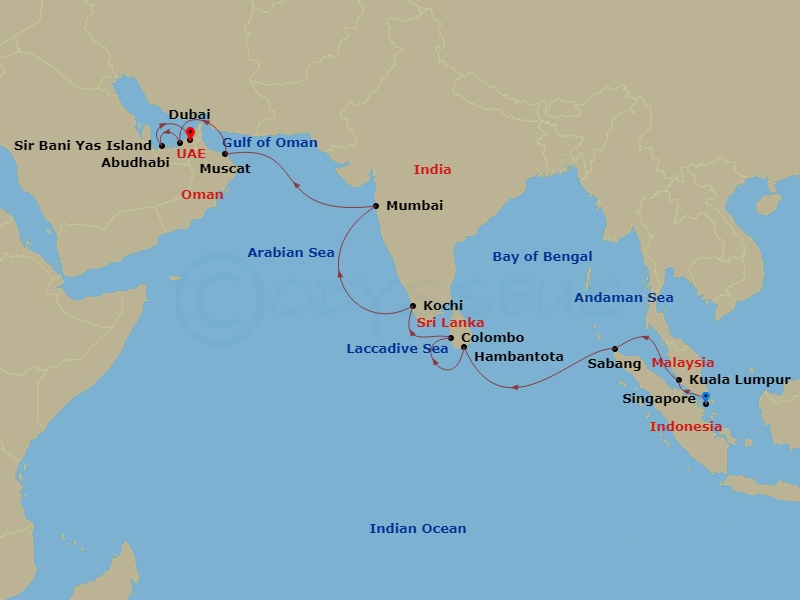With a population exceeding 18 million, this one time group of low lying mud flats is now India’s economic power base and her most industrialized city, bustling with activity of incredible diversity and complexity, her color and elegance, her wealth corresponding with her historic struggle against poverty. Certain affluent areas give Bombay an air of mini–Manhattan!
8:30am - 9:30am:
Depart the pier for the famous Gateway of India en route to Banganga. This Indo-Saracenic archway was built in 1911 to commemorate the visit of King George V and Queen Mary, and is the city's most famous landmark.
We then proceed to Banganga via Art Deco Marine Drive also called the Queens Necklace at night due to its curve shape around the bay.
9:30am - 10:30am
Walk around Banganga, the sacred tank surrounded by four hundred-year-old temples and modern skyscrapers. Nowhere are Bombay’s paradoxes more evident than at Banganga. Part of an ancient temple complex, the water in this tank is believed to come from the Holy Ganges. It sprung forth when Rama, the exiled hero of the epic Ramayana stopped at the spot five thousand years ago, in search of his kidnapped wife Sita. Overcome with fatigue and thirst, he asked his brother Laxman to bring him some water. Laxman instantly shot an arrow into the ground, and water gushed forth from the Ganga, over a thousand miles away. Although the story is the stuff of legend, the tank has always been sacred. On pious occasions, thousands turn up to take a ritual dip in its mossy waters, and offer flowers at the ancient Banganga Temples.
10:30am - 10:50am
Drive to Dhobi Ghat.
10:50 - 11:15
Visit the `Dhobi Ghat’, the city’s open-air laundry! where “Dhobis’ (washermen) attend to an astounding quantity of washing daily. Clothes, linen, towels… are washed in small open air cubicles rented out each day. An itemized account is logged in a notebook and clothes collected from households are returned a week later. Through the apparent chaos incredibly nothing gets lost from a countless number of pieces and most clothes somehow survive the beating they receive on the washing stones.
11:15pm - 11:45pm
Drive to Churchgate Railway Station.
11:45am - 12:15pm
We stop at the Churchgate Railway Station to see the `Dabbawallahs’, members of the Bombay Union of Tiffin Box Carriers, described by Prince Charles as the symbol of this enigmatic and intriguing city. Each morning, the 2500 dabbawallahs call on suburban housewives who pack a freshly cooked lunch into small circular aluminum or stainless steel containers - `dabbas’. Typically the dabbawallahs collect 30-40 boxes, range them out on a long pole and cycle to the nearest station. Here he hands them over to a fellow dabbawallah who then transports them into the city for delivery to the consumer. Over 100,000 lunches of maybe sabze (vegetable curry), chapattis (Indian bread), dal (lentils) and pickle, make their way daily across town to the breadwinner and back again. The service which costs a few rupees a week, is a good example of the fine division of labor in India, reliable and efficient for the dabbawallahs pride themselves on never losing a lunch.
12:15pm - 12:30pm
Drive to `Khyber’ restaurant for lunch which specializes in the Northwest frontier cuisine.
12:30pm - 2:00pm
Lunch (on own)
2:00pm - 2:30pm
Drive to Mani Bhawan passing through the teeming commercial areas, Crawford Market and many handsome buildings of Victorian Bombay, including the University and Victoria Terminus.
2:30pm - 3:15pm
Visit the Gandhi Museum. Located on leafy Laburnum Road, a quiet lane named after its shady trees, Mani Bhavan is the old Mumbai residence of Mahatma Gandhi. It's a pretty, two-storied structure that now houses a reference library with over 2000 books, a photo exhibition of the Mahatma's life, and well preserved memorabilia, including an old charkha or spinning wheel that Gandhiji used to use.
3:15pm - 4:45pm
Before returning to the pier, we spend some time where it all began, where the tide of human life rolls down the center of the street, unruffled by vehicles from all quarters ploughing their way through it. No visit to Bombay is complete without a foray into the bazaars of Bhuleshwar. The city’s densest concentration of lifestyle and retail jewelry stores is a crush of shop fronts, street stalls, hawkers and handicrafts and a seething mass of people. It may look like absolute chaos but the areas are closely knit, and cohesively built around the traditional residential complex, temples, flower markets, community halls, cow shelter and bazaars. Within a few square kilometers there are a dozen bazaars and more commodities for sale than you will see probably anywhere else in a lifetime.
4: 45 - 5:30
Drive back to the ship.
Added Value:
- A good overview of the unique aspects of this unique city.
- Tour Duration: 8 – 9 hours
- Tour can operate : Morning
- Physical activity level : Moderate
- Wheelchair Accessible : No
Inclusions:
- Transportation by an air-conditioned vehicle
- Services of a local English speaking guide.
- All the entrance fees and camera fees.
- Credit card and bank charges.
- All the prevailing taxes.













